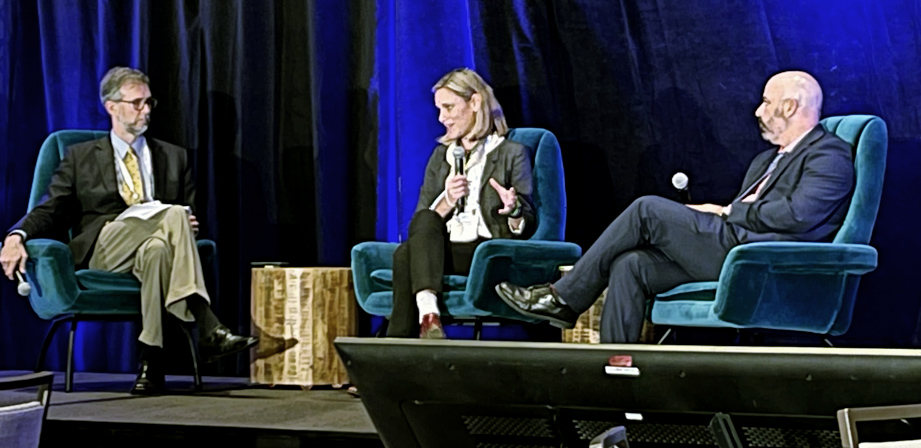
BOSTON — As part of series of opening keynotes at the American Clean Power Association’s Offshore WINDPOWER 2021 conference, U.S. Secretary of the Interior Deb Haaland announced plans for the Bureau of Ocean Energy Management to potentially hold up to seven new OSW lease sales by 2025 in the Gulf of Maine, New York Bight, Central Atlantic and the Gulf of Mexico, in addition to the Carolinas, California and Oregon.
During a subsequent panel on permitting improvements, BOEM Renewable Energy Program Manager James Bennett said Haaland’s announcement represents “a path forward.”
“It does identify where we’re going and what we’re doing,” Bennett said. “This is not the first time we have attempted to put together and lay out a path forward, but it is the first time that we have been successful in being able to share with the public and specifically identify when lease sales are targeted for the near future.”

Massachusetts has targeted net-zero emissions by 2050, and at least 15 GW of OSW are needed, according to the state’s Decarbonization Roadmap. Energy and Environmental Affairs Secretary Kathleen Theoharides said that forward momentum on new lease areas “is a great, exciting announcement that probably should have received a lot more clapping from this audience.”
“It’s another piece of the puzzle to this whole question,” Theoharides said.
The Federal Permitting Improvement Steering Council (FIPSC) helps fit the puzzle pieces by overseeing interagency coordination and process improvements. With the Biden administration using a whole-of-government approach to deploy 30 GW of OSW by 2030, FIPSC Executive Director Christine Harada said from an efficiency perspective, “there’s a lot of work that we need to do within a very limited amount of time.”
Project uncertainty is challenging some of the agencies regarding how to permit something or how to evaluate the impacts under their statutory mandates, according to Scott Lundin, head of U.S. permitting and environmental affairs at Equinor. For example, Lundin said the Block Island Wind Farm began operations in 2016 with five 6-MW turbines, but General Electric announced that its turbines can now generate 14 MW of power.
“There’s a concern and a risk that alternatives get defined that are not technically, commercially, environmentally feasible,” Lundin said. “I think the opportunity for the developers to help inform and shape perspectives of these different agencies about the value and the need to bring these products to commercial operation is something that we’re very interested in facilitating whenever possible.”
Theoharides on Baker Announcement
After the permitting panel’s conclusion, Theoharides told RTO Insider that the announcement of legislation by Massachusetts Gov. Charlie Baker (R), which would create a $750 million clean energy investment fund and refine the current OSW procurement process, is “significant.”
“What it will open up for us here in Massachusetts is a chance to ensure that not only are we aggressively pursuing our net-zero targets, but we are leading the industry to design the solutions and then to retain those jobs right here in Massachusetts and in the Northeast,” Theoharides said.
The main change to the OSW procurement process would be the transfer of authority to select the winning bidder from state’s electric distribution companies like Eversource and National Grid to the Department of Energy Resources. However, EDCs would remain participants in the evaluation and provide technical advice to the department.
Theoharides said that taking the EDCs “out of the game” of choosing which company will win the bid makes procurements “more efficient” and “more objective process overall.”
Baker’s legislation comes on the heels of a plan by his administration to also direct $900 million in federal aid from the American Rescue Plan Act toward vital energy and environmental initiatives, including $100 million to invest in port infrastructure to support OSW. Theoharides said the $100 million would “kick off” port infrastructure work, and the state would look to leverage additional private investments.
Markey: Politics Hinder Renewable Energy Progress
U.S. Sen. Ed Markey (D-Mass.) said during an interview Thursday that the only thing stopping the progress on renewable energy sources like OSW is “politics and not technology.”
“If we didn’t have political opposition that was in place, the technology would have evolved much more quickly,” Markey said.
The target of 30 GW of OSW by 2030 set earlier this year is “modest,” according to Markey. However, he also thinks political opposition will be funded by the fossil fuel industry, especially at the ballot box.
“The fossil fuel industry is going to try to take the 2024 election, make it a referendum, bring back a gang that is tied to the fossil fuel generation strategy,” Markey said.
Markey introduced a bill in September that would create a 30% investment tax credit for U.S. manufacturers to produce qualified OSW components and dedicated vessels. “We’ve tailored the solutions to the exact needs of the industry to get the policies that fit to reduce the high capital costs that manufacturers face,” Markey said.

